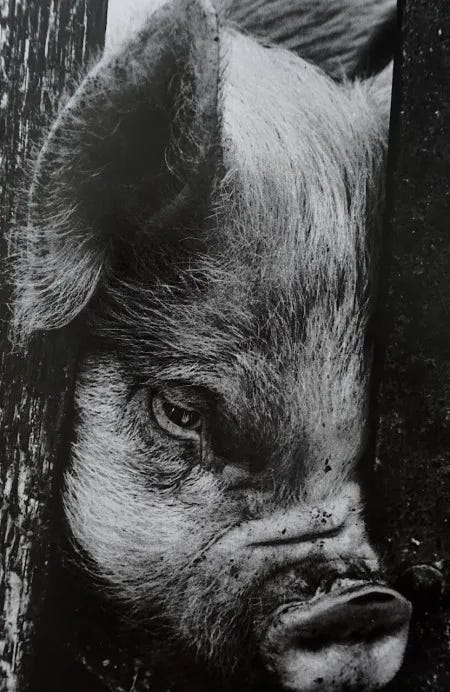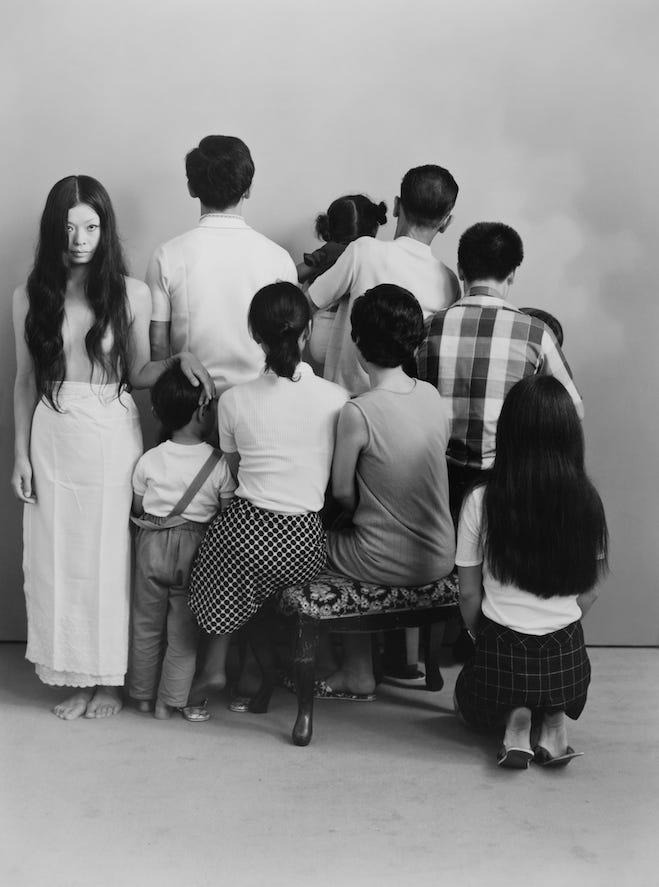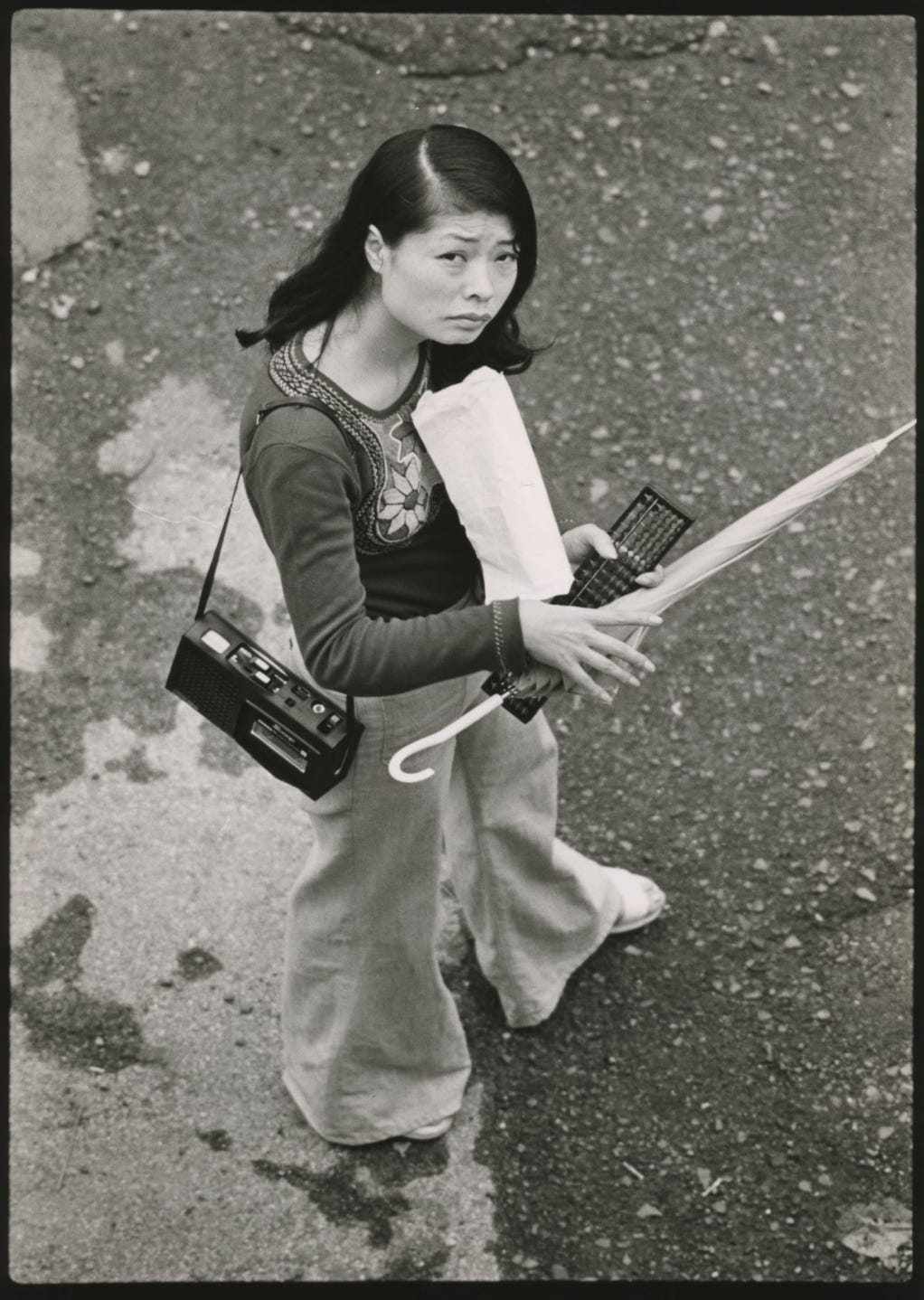Masahisa Fukase: Obsession, Love and Tragedy
“Obsession is just care that refuses to turn down its volume.”
I wasn’t prepared to write about Masahisa Fukase today. I had another piece half-drafted, but then came the late-night scroll, Tatiana Hopper’s video about the photographer whose love for pictures supposedly consumed his life, and that familiar feeling of falling down a rabbit hole. A few minutes later I was holding Ravens in my hands again. The book still feels heavier than it should. Not because of paper weight. Because it carries weather inside it. Turning the pages, the room grew colder. The birds don’t just fly, they haunt.
There is a reason people still talk about Fukase. His pictures are intimate without turning sentimental. They feel like rubbing salt into an open wound to see if it still stings. The easy myth says a man loved photography so much it ruined him. The truer story is messier. The work and the life were not separate. The work is how he lived, how he argued, how he apologized, how he documented loss and sometimes how he controlled what he could not control. That is why Ravens still lands so hard, and why his earlier pictures of Yōko, his family, his cats, and even a Tokyo slaughterhouse echo one another like rooms in the same house.
If there's one thing you know about Fukase, it's probably that he made Ravens. If you know two things, the second is probably Yōko. If you know three things, you will have heard about the accident in Shinjuku and the years he spent in a coma. All of this is true, and it matters, but it is not enough on its own. Let's go back to the beginning and see what was happening before the birds arrived.
Where it starts: a small town studio, a big city education
Fukase was born in 1934 in Bifuka, Hokkaido. His parents ran a photo studio, which already feels like destiny: childhood surrounded by portraits, chemistry trays and the quiet hum of business. He studied photography in Tokyo, worked in advertising, then went freelance.
Growing up in postwar Japan, he was also shaped by the atmosphere of Hiroshima and Nagasaki, where the devastation left a cultural backdrop of loss, resilience and questioning that hung over his generation. Even when his pictures got strange, the craft never slipped.
By the mid 1970s he helped start The Workshop, a short lived school with peers like Daido Moriyama and Shōmei Tōmatsu.
That context matters because it situates him inside a generation pushing Japanese photography toward diary, performance, and what critics later called I photography. It also reminds us that he was not an isolated genius. He was part of a community that argued and experimented together.
Before Yōko and before the birds: ritual at the slaughterhouse
Early in the 1960s Fukase kept returning to the Shibaura slaughterhouse in Tokyo. The series is often called Kill the Pig. The pictures are blunt and unflinching. You can almost smell iron in the air. This is not cruelty for spectacle. It is ritual and labor, the part of modern life that keeps us going while staying neatly out of sight. The choice to look there tells you something about his default setting. He goes where the polite story breaks down.
Yōko enters: love, play and the window as a stage
Everyone talks about Yōko Wanibe and for good reason. She was Fukase’s second wife and the gravitational center of so many pictures. She was an actress, which is true and also a little too neat. Actors know how to play to a camera. Wives are not props. Their collaboration is documented in frames that swing between play and tension, intimacy and a low hum of surveillance.
In the summer of 1973, living on the fourth floor of an apartment building, Fukase photographed Yōko each morning as she left for work. He used a telephoto lens from the window. Same vantage, same ritual, tiny daily variations. Sometimes she performs. Sometimes she refuses. Sometimes she looks straight up and laughs. He called the project From Window. In 2024 a show at Michael Hoppen Gallery presented a fuller set, which helped viewers outside Japan see how much range lives inside this simple domestic choreography.
The first book reads like a mirror you are not ready for
In 1971 Fukase published Yūgi. In English you will see the subtitle rendered as Homo Ludens most often, and sometimes as Homo Ludence in retail and reprint listings. Either way, it works like an autobiography that refuses to be literal. Lovers, family, cats and the slaughterhouse all appear like actors in a play about identity. Recent reprints have made it easier to see again.
Love story, possession story, or both
Accounts agree that the marriage ended in 1976. That part is history. The tone is harder. Calling the Yōko work obsessive is fair. Calling it only obsessive misses the collaboration that also lived there. In 1978 the book Yōko appeared from Asahi Sonorama. It threads raven pictures between chapters of a relationship. That editorial decision feels like foreshadowing that cannot be unseen once you know what came next.
I can’t imagine pointing a camera at someone I love every morning. And yet… I know the itch of turning routine into ritual, of wondering if documenting closeness destroys it. Those frames feel uncomfortably familiar even without the telephoto lens.
“Being someone’s subject every day can turn love into a job.”
The birds arrive, and the world finally looks like how it feels
The simple version goes like this. The marriage ended in 1976. He drifted north. Ravens began appearing in frame after frame. They weren’t birdwatching trophies. They were weather reports from inside him. Black arcs in snow. A wing like a brushstroke. A language built out of persistence.
When Ravens was finally published in 1986, critics slowly caught up to what the pictures had been saying all along: grief doesn’t need a caption. Sequence, tone, and rhythm carry it. A single raven picture is striking. A run of them becomes a score you feel in your chest.
What never ceases to surprise me with each re-read is how the simplicity is a deliberate choice. Reducing living creatures to almost pure graphic form turns nature into signs that can be arranged and controlled. That is not neutral. It's a survival strategy based on editing. It's a way of saying, I'm going to take this chaotic day and turn it into something I can control.
The first time I saw Ravens I thought I understood it. I was wrong. I was a little too young and a little too eager to project a single mood onto a complex score. Years later, after breakups, family illness, and the quiet losses that accumulate if you stay alive long enough, the book changed for me. I started noticing the frames that are almost funny in their stubbornness. A blob of black in a storm of snow. A near miss. A picture that should not work and does. Those have become the frames I trust most.
This is also where I remind myself that grand subjects are a myth. Fukase built universes with a window, a bath, a studio backdrop, a hometown street and a train platform. He clicked at what was already there. That is strangely liberating. Waiting for the perfect subject is a reliable way to avoid beginning.
Bathwater as mirror, the last playful pictures
Near the end of his working life Fukase made Bukubuku, a series of underwater self portraits in the bath. They’re goofy and morbid at the same time, which feels exactly right. A face flattened by the waterline. Bubbles erupt that turn the mask into a temporary sculpture. The camera stares. The bath stares back. The images circulated widely posthumously and were shown at Tate Modern in the exhibition Performing for the Camera. They read like a dare. What if the final mirror is not glass but a tank of water? What if the person looking is mid disappearance?
Cats and breathing between storms
It would be a mistake to read the career as only grief. The cat pictures, especially the books around Sasuke and Momoe, are pure relief. You can feel the camera drop to their eye level. There is play and patience and genuine delight. If Ravens is the high drama, cats are how you breathe between those acts.
Family, the studio as a time machine
Family gathers portraits made over years in the Bifuka studio. The pictures are formal and strange at once. People face the camera. Time passes. The cast changes. The room grows emptier. A studio portrait is not just evidence. It is a ritual that asks a question about who counts and who remains. Looking at them, I thought of my own family photos, the ones I avoid because absence is harder to look at than presence.
The fall, the coma, the archive
1992, Shinjuku, Golden Gai. Fukase falls down a stairway at a favorite bar. He never regains consciousness and remains in a coma until his death in 2012. The accident is part of the story, but not the meaning of the work. What moves me is that friends and colleagues kept the pictures alive for him, through reprints, archives, exhibitions. It makes me wonder: who, if anyone, would do that for me?
Why this still matters now
Three reasons.
One: Intimacy (in art) is complicated. The Yōko pictures are a case study. They are collaborative and invasive at once. A love letter and a boundary test. If you make work about people you know, these pages force you to treat consent as a practice rather than a checkbox.
Two: Form can carry a feeling without text. Plenty of photographers point lenses at birds. Ravens is not about rare access. It is about sequences, tonal decisions, and graphic reduction. The pictures read as feeling first. The subject comes second. Ravens is proof that sequence and rhythm can say more than captions ever could.
Three: The myth is wrong. People say photography ruined his life. The accident is not made by a camera. The work is how he lived. The price of that devotion is real for him and for the people around him. The gift is also real. It gives shape to feelings that are hard to name.
“Do not wait for a perfect subject. You already have one. It is your life.”
Questions I still cannot shake
What if your partner becomes your primary subject? Can life and art avoid cannibalising each other? The Yōko pictures leave this question unanswered.
Is the raven only a stand in for personal grief, or also a sign for something larger in postwar Japanese weather? The best readings allow both.
What is the real gap between a casual bath selfie and Bukubuku? Some of it is print quality and intention. A lot of it is patience and a willingness to photograph a face you cannot fully control.
Technique, printing, and sequencing
Ravens works because the printing goes all in on tonal extremes. Deep blacks hold shape without collapsing. Midtones are present but not sentimental. Highlights are often left as open snow or sky so that the bird can read as a cutout. Many spreads use near symmetry to keep the eye moving across the gutter. Repetition does the heavy lifting. A single raven picture is interesting. A run of them is language. The edit pushes the rhythm toward breath and then toward a quiet choke. That is why the book feels like weather.
From Window lives on a different kind of craft. The constraint is the form. Same place. Same time. Similar lens. It is a durational performance and an edit challenge. What do you keep when the differences are small? You keep stance, gesture, facial micro shifts, the times when play turns into annoyance, and the one morning when everything clicks and an exchange becomes a photograph that carries more than documentation.
The present tense of a past life
In the last decade the work has been everywhere again. Galleries and publishers have been doing careful work. From Window received a full show in London in 2024, which finally let a broader audience see the daily cycle as a complete performance. The 2017 MACK edition of Ravens remains the easiest high fidelity path into the book. The Archives have supported reprints of early projects and organized retrospectives that present the big bodies of work together. A biographical film titled Ravens toured festivals with Tadanobu Asano portraying Fukase. The attention has not smoothed the rough edges. It has made the contradictions more visible, which is good.
Final Take
People like to say obsession made Fukase great or destroyed him. I don’t buy either. Obsession is just care that refuses to turn down its volume. It is risky to live that way. It is also how some necessary art gets made. These photographs do not ask for approval. They ask for your attention. They ask you to notice that love can be awkward and generous at the same time. They ask you to notice that grief can be loud, or it can be a black shape that returns to the same branch until you learn its language.
Every time I close Ravens, I feel the room change temperature. Not because of him. Because the book trains me to notice my own weather, and once you learn that, you can’t unlearn it.
Catch you next time,
Paula















Great article ❤️